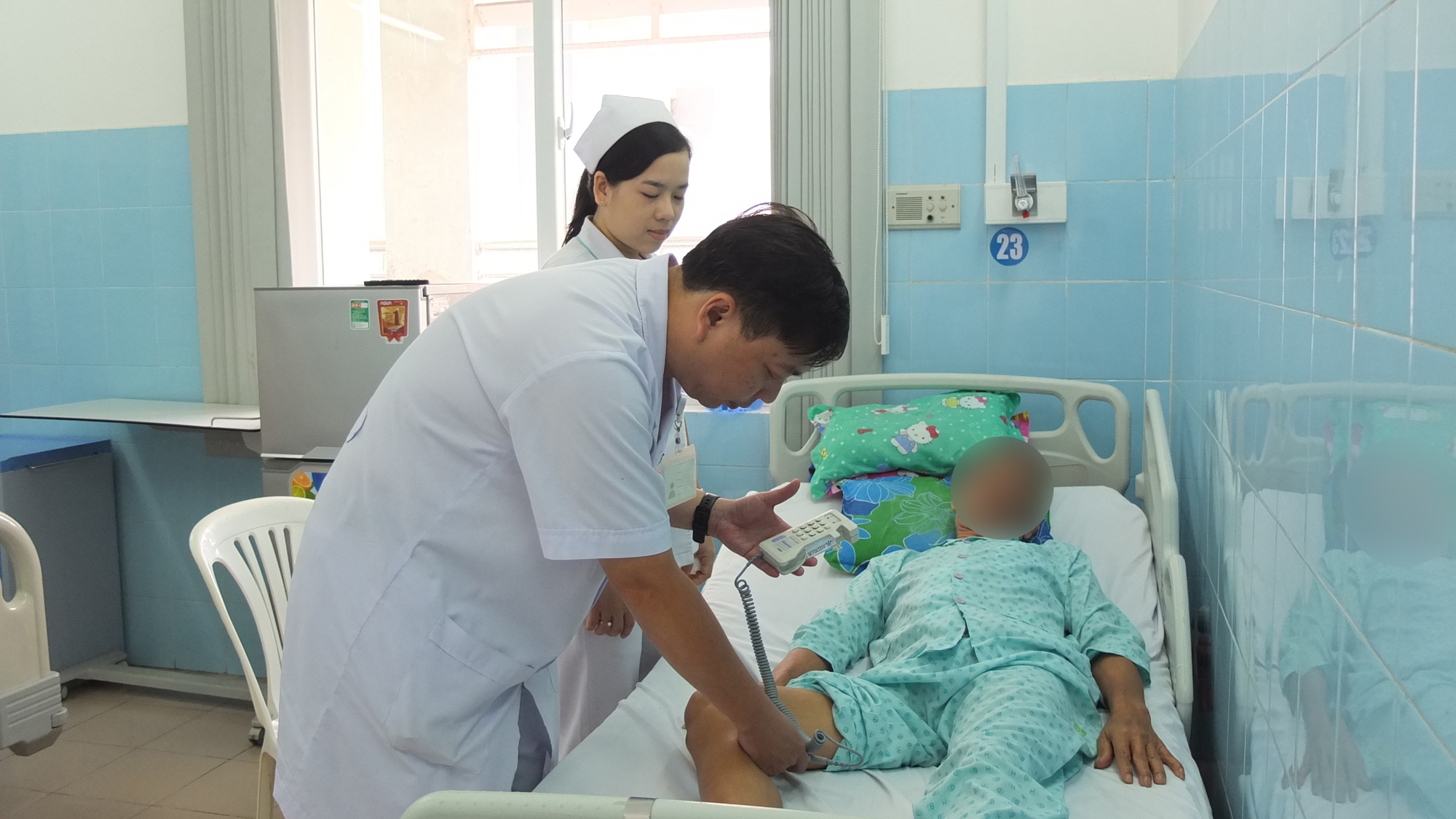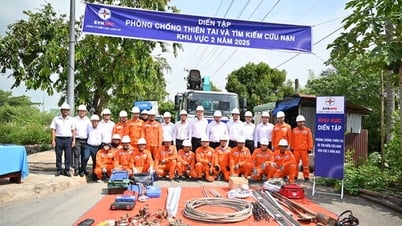Hoan My Saigon Hospital (HCMC) has just provided timely emergency care to Mr. LQC (64 years old, living in District 12) who suffered from an abdominal aortic aneurysm that was close to rupture. Mr. C. was admitted to the emergency room with severe abdominal pain, the pain spreading to the lower back.
Save many patients in time
According to his family, a few days before being admitted to the hospital, Mr. C. only had mild pain in his lower back, but the pain gradually became more severe. At the hospital, the test results showed that he had a 7 cm abdominal aortic aneurysm above the kidney, with aortic dissection and a threat of rupture. The patient also had many other medical conditions such as diabetes, hypertension, Cushing's syndrome, dyslipidemia, etc.
Recognizing the high risk of death, although the success rate was only 50%, the doctors decided to perform emergency surgery to save the patient. The aneurysm was treated, a bridge was made from the thoracic aorta to the left renal artery, the abdominal aorta was replaced with an artificial graft and the blood vessels that fed the organs were transferred to the graft. After surgery and intensive treatment, Mr. C. overcame the critical condition.
According to MSc. Luong Cong Hieu, Department of Cardiovascular and Thoracic Surgery, Hoan My Saigon Hospital, Mr. C's case must be quickly and accurately diagnosed as an aortic aneurysm threatening to rupture. If not diagnosed correctly and treated promptly, Mr. C will die from blood loss. When an aortic aneurysm is about to rupture, the patient often has symptoms of chest pain, abdominal pain, severe back pain, difficulty breathing, pale skin, low blood pressure, etc. The chance of saving a patient with an aortic aneurysm threatening to rupture is often very slim.

A patient with an aneurysm as big as an orange was discovered and saved in time by doctors at Binh Dan Hospital, Ho Chi Minh City.
Many hospitals in Ho Chi Minh City such as Cho Ray, University of Medicine and Pharmacy, 115, Gia Dinh... also receive many cases of aneurysms like this "time bomb".
A memorable case that was promptly saved by doctors at Gia An 115 Hospital in Ho Chi Minh City was an elderly woman named NT T (82 years old, living in Binh Tan District), who had a pulsating aneurysm right at her navel. Abdominal ultrasound results showed that the patient had an aortic aneurysm measuring 37x40x50 mm, with a very high risk of rupture.
According to Dr. Duong Duy Trang, Deputy Director of Gia An 115 Hospital and Head of the Department of Cardiology - Interventional Cardiology, with the support of technical equipment and the experience of the doctor, this case was treated with the fastest intervention: placing a Stent Graft inside the aneurysm, completely removing the aneurysm.
At Binh Dan Hospital in Ho Chi Minh City, doctors from the Cardiovascular Surgery Department also successfully performed emergency surgery on a 57-year-old man from Dak Lak who had an abdominal aortic aneurysm as big as an orange, measuring 9.2 x 8.2 cm; ankylosing spondylitis. This is an extremely dangerous condition because the aneurysm can rupture at any time, especially during strong movements or collisions. The patient even rode his motorbike to get a health check-up and was completely unaware of the existence of a giant aneurysm in his abdomen.
Aneurysm rupture, 80% mortality despite emergency care
Associate Professor, Doctor, Doctor Tran Vinh Hung, Director of Binh Dan Hospital, said that abdominal aortic aneurysm is a condition in which the artery is dilated more than normal, the vessel wall gradually becomes thin and weak, and there is a risk of sudden rupture due to blood pressure. The abdominal aorta is the largest artery in the body, carrying blood from the heart to the organs in the lower half of the body. A ruptured aneurysm can cause death at any time. Most patients are discovered by chance through abdominal ultrasound or by feeling a bulge in the abdomen that beats with the heartbeat.
"For patients with abdominal aortic aneurysms, when symptoms such as abdominal pain, fainting, etc. appear, it is necessary to consider the possibility that the aneurysm has ruptured. When the aneurysm ruptures, if surgery is not performed promptly, the patient will quickly die," Associate Professor Hung emphasized.
According to experts, an aneurysm is an abnormal dilation of an artery due to a weakening of the arterial wall (an increase of more than 50% in diameter compared to the normal segment), mainly due to causes such as high blood pressure, atherosclerosis, infection, trauma or genetic diseases such as Marfan syndrome, Ehlers-Danlos syndrome. Aneurysms can occur in any artery, the most common being abdominal and thoracic aortic aneurysms. This disease progresses silently and is often asymptomatic, usually only appearing when the disease has complications such as embolism, arterial dissection, aneurysm rupture, etc.
Aortic aneurysm rupture is an extremely dangerous complication that can cause rapid death and the mortality rate after surgery or emergency intervention is recorded as high as 80%. Therefore, in addition to medical treatment of associated diseases (hypertension, dyslipidemia, infection, etc.), the aortic aneurysm needs to be closely monitored and operated or intervened at the appropriate time to prevent complications of aneurysm rupture.
Dr. Luong Cong Hieu recommends regular health check-ups, especially for the elderly, including abdominal ultrasound to help detect and promptly treat aneurysms by surgically removing the aneurysm or placing an endovascular stent, to prevent the aneurysm from growing larger and suddenly rupturing.
"Conducting regular imaging tests (ultrasound and CTA) under the guidance of a specialist will help patients with aortic aneurysms have a better treatment plan. Proactive surgical intervention at the right time will help reduce the risk for the patient a lot compared to emergency intervention" - Dr. Hieu recommends.
New technique reduces complications
According to experts, with the Stent Graft intervention technique, doctors will insert a catheter into the blood vessel through a small hole in the groin or arm up to the aneurysm and place it firmly in the artery. This is a minimally invasive technique so it has many advantages over open surgery: reducing hospital stay and recovery time, reducing the risk of infection, and reducing blood loss for the patient.
Source



![[Photo] Top players gather at the 2025 Nhan Dan Newspaper National Table Tennis Championship](https://vphoto.vietnam.vn/thumb/1200x675/vietnam/resource/IMAGE/2025/5/23/9ad5f6f4faf146b08335e5c446edb107)




























































































Comment (0)